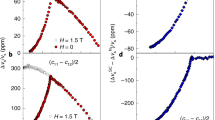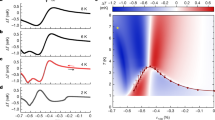Abstract
Sr2RuO4 has stood as the leading candidate for a spin-triplet superconductor for 26 years1. However, recent NMR experiments have cast doubt on this candidacy2,3 and it is difficult to find a theory of superconductivity that is consistent with all experiments. The order parameter symmetry for this material therefore remains an open question. Symmetry-based experiments are needed that can rule out broad classes of possible superconducting order parameters. Here, we use resonant ultrasound spectroscopy to measure the entire symmetry-resolved elastic tensor of Sr2RuO4 through the superconducting transition. We observe a thermodynamic discontinuity in the shear elastic modulus c66, which implies that the superconducting order parameter has two components. A two-component p-wave order parameter, such as px + ipy, naturally satisfies this requirement. As this order parameter appears to have been precluded by recent NMR experiments, we suggest that two other two-component order parameters, namely \(\{{d}_{xz},{d}_{yz}\}\) and \(\{{d}_{{x}^{2}-{y}^{2}},{g}_{xy({x}^{2}-{y}^{2})}\}\), are now the prime candidates for the order parameter of Sr2RuO4.
This is a preview of subscription content, access via your institution
Access options
Access Nature and 54 other Nature Portfolio journals
Get Nature+, our best-value online-access subscription
$29.99 / 30 days
cancel any time
Subscribe to this journal
Receive 12 print issues and online access
$209.00 per year
only $17.42 per issue
Buy this article
- Purchase on Springer Link
- Instant access to full article PDF
Prices may be subject to local taxes which are calculated during checkout



Similar content being viewed by others
Data availability
Source data are provided with this paper. All other data that support the plots within this paper and other findings of this study are available from the corresponding author upon reasonable request.
References
Maeno, Y. et al. Superconductivity in a layered perovskite without copper. Nature 372, 532–534 (1994).
Pustogow, A. et al. Constraints on the superconducting order parameter in Sr2RuO4 from oxygen-17 nuclear magnetic resonance. Nature 574, 72–75 (2019).
Ishida, K., Manago, M., Kinjo, K. & Maeno, Y. Reduction of the 17O Knight shift in the superconducting state and the heat-up effect by NMR pulses on Sr2RuO4. J. Phys. Soc. Jpn 89, 034712 (2020).
Rice, T. M. & Sigrist, M. Sr2RuO4: an electronic analogue of 3He? J. Phys. Condens. Matter 7, L643–L648 (1995).
Baskaran, G. Why is Sr2RuO4 not a high Tc superconductor? Electron correlation, Hund’s coupling and p-wave instability. Physica B Condens. Matter 223, 490–495 (1996).
Bergemann, C., Julian, S. R., Mackenzie, A. P., Nishizaki, S. & Maeno, Y. Detailed topography of the Fermi surface of Sr2RuO4. Phys. Rev. Lett. 84, 2662–2665 (2000).
Mackenzie, A. P., Scaffidi, T., Hicks, C. W. & Maeno, Y. Even odder after twenty-three years: the superconducting order parameter puzzle of Sr2RuO4. npj Quantum Mater. 2, 40 (2017).
Ishida, K. et al. Spin-triplet superconductivity in Sr2RuO4 identified by 17O Knight shift. Nature 396, 658–660 (1998).
Kittaka, S. et al. Angular dependence of the upper critical field of Sr2RuO4. Phys. Rev. B 80, 174514 (2009).
Luke, G. M. et al. Time-reversal symmetry-breaking superconductivity in Sr2RuO4. Nature 394, 558–561 (1998).
Xia, J., Maeno, Y., Beyersdorf, P. T., Fejer, M. M. & Kapitulnik, A. High resolution polar Kerr effect measurements of Sr2RuO4: evidence for broken time-reversal symmetry in the superconducting state. Phys. Rev. Lett. 97, 167002 (2006).
Jang, J. et al. Observation of half-height magnetization steps in Sr2RuO4. Science 331, 186–188 (2011).
Ghosh, S. et al. One-component order parameter in URu2Si2 uncovered by resonant ultrasound spectroscopy and machine learning. Sci. Adv. 6, eaaz4074 (2020).
Okuda, N., Suzuki, T., Mao, Z., Maeno, Y. & Fujita, T. Unconventional strain dependence of superconductivity in spin-triplet superconductor Sr2RuO4. J. Phys. Soc. Jpn 71, 1134–1139 (2002).
Lupien, C. Ultrasound attenuation in the unconventional superconductor Sr2RuO4. PhD thesis, Univ. of Toronto (2002).
Benhabib, S. et al. Ultrasound evidence for a two-component superconducting order parameter in Sr2RuO4. Nat. Phys. https://doi.org/10.1038/s41567-020-1033-3 (2020).
Walker, M. B. & Contreras, P. Theory of elastic properties of Sr2RuO4 at the superconducting transition temperature. Phys. Rev. B 66, 214508 (2002).
Migliori, A. et al. Resonant ultrasound spectroscopic techniques for measurement of the elastic moduli of solids. Physica B Condens. Matter 183, 1–24 (1993).
Ramshaw, B. J. et al. Avoided valence transition in a plutonium superconductor. Proc. Natl Acad. Sci. 112, 3285–3289 (2015).
Forsythe, D. et al. Evolution of Fermi-liquid interactions in Sr2RuO4 under pressure. Phys. Rev. Lett. 89, 166402 (2002).
Grinenko, V. et al. Split superconducting and time-reversal symmetry-breaking transitions, and magnetic order in Sr2RuO4 under uniaxial stress. Preprint at https://arxiv.org/abs/2001.08152v2 (2020).
Hicks, C. W. et al. Strong increase of Tc of Sr2RuO4 under both tensile and compressive strain. Science 344, 283–285 (2014).
Li, Y.-S. High sensitivity heat capacity measurements on Sr2RuO4 under uniaxial pressure. Preprint at https://arxiv.org/abs/1906.07597 (2020).
Watson, C. A., Gibbs, A. S., Mackenzie, A. P., Hicks, C. W. & Moler, K. A. Micron-scale measurements of low anisotropic strain response of local Tc in Sr2RuO4. Phys. Rev. B 98, 094521 (2018).
Hassinger, E. et al. Vertical line nodes in the superconducting gap structure of Sr2RuO4. Phys. Rev. X 7, 011032 (2017).
Sharma, R. et al. Momentum-resolved superconducting energy gaps of Sr2RuO4 from quasiparticle interference imaging. Proc. Natl Acad. Sci. 117, 5222–5227 (2020).
Rømer, A. T., Scherer, D. D., Eremin, I. M., Hirschfeld, P. J. & Andersen, B. M. Knight shift and leading superconducting instability from spin fluctuations in Sr2RuO4. Phys. Rev. Lett. 123, 247001 (2019).
Lupien, C. & et al. Ultrasound attenuation in Sr2RuO4: an angle-resolved study of the superconducting gap function. Phys. Rev. Lett. 86, 5986–5989 (2001).
Žutić, I. & Mazin, I. Phase-sensitive tests of the pairing state symmetry in Sr2RuO4. Phys. Rev. Lett. 95, 217004 (2005).
Kittaka, S. et al. Searching for gap zeros in Sr2RuO4 via field-angle-dependent specific-heat measurement. J. Phys. Soc. Jpn 87, 093703 (2018).
Ramires, A. & Sigrist, M. Superconducting order parameter of Sr2RuO4: a microscopic perspective. Phys. Rev. B 100, 104501 (2019).
Suh, H. G. et al. Stabilizing even-parity chiral superconductivity in Sr2RuO4. Phys. Rev. Res. 2, 032023 (2020).
Haverkort, M. W., Elfimov, I. S., Tjeng, L. H., Sawatzky, G. A. & Damascelli, A. Strong spin-orbit coupling effects on the Fermi surface of Sr2RuO4 and Sr2RhO4. Phys. Rev. Lett. 101, 026406 (2008).
Tamai, A. et al. High-resolution photoemission on Sr2RuO4 reveals correlation-enhanced effective spin-orbit coupling and dominantly local self-energies. Phys. Rev. X 9, 021048 (2019).
Kivelson, S. A., Yuan, A. C., Ramshaw, B. J. & Thomale, R. A proposal for reconciling diverse experiments on the superconducting state in Sr2RuO4. npj Quantum Mater. 5, 43 (2020).
Raghu, S., Berg, E., Chubukov, A. V. & Kivelson, S. A. Effects of longer-range interactions on unconventional superconductivity. Phys. Rev. B 85, 024516 (2012).
Bobowski, J. S. et al. Improved single-crystal growth of Sr2RuO4. Condens. Matter 4, 6 (2019).
Mackenzie, A. P. et al. Extremely strong dependence of superconductivity on disorder in Sr2RuO4. Phys. Rev. Lett. 80, 161–164 (1998).
Acknowledgements
We acknowledge helpful discussions with K. Modic, S. Kivelson, I. Mazin, D. Agterberg, R. Thomale, P. Hirschfeld, R. Fernandes, I. Paul, C. Proust and L. Taillefer. B.J.R. and S.G. are grateful for help with the experimental design from E. Smith and J. Parpia, and from the machine shop staff of the Laboratory of Atomic and Solid State Physics at Cornell University. B.J.R and S.G. acknowledge support for building the experiment, collecting and analysing the data, and writing the manuscript from the Office of Basic Energy Sciences of the United States Department of Energy under award no. DE-SC0020143. B.J.R. and S.G. acknowledge support from the Cornell Center for Materials Research with funding from the Materials Research Science and Engineering Centers program of the National Science Foundation (cooperative agreement no. DMR-1719875). A.S. acknowledges support from the National High Magnetic Field Laboratory, which is supported by the National Science Foundation (cooperative agreement no. DMR-1644779) and the State of Florida. N.K. acknowledges support from KAKENHI (Grants-in-Aid for Scientific Research, grant no. JP18K04715) of the Japan Society for the Promotion of Science.
Author information
Authors and Affiliations
Contributions
S.G. and B.J.R. designed the experiment. F.J., D.A.S., N.K., M.B., C.W.H. and A.P.M. prepared the crystal and performed characterization measurements. S.G. acquired and analysed the ultrasound data. S.G., A.S., C.W.H. and B.J.R. wrote the manuscript with input from all co-authors.
Corresponding author
Ethics declarations
Competing Interests
The authors declare no competing interests.
Additional information
Peer review information Nature Physics thanks Johnpierre Paglione and the other, anonymous, reviewer(s) for their contribution to the peer review of this work.
Publisher’s note Springer Nature remains neutral with regard to jurisdictional claims in published maps and institutional affiliations.
Extended data
Extended Data Fig. 1 RUS frequency data.
Temperature evolution of 18 resonance frequencies of Sr2RuO4 through Tc, with panels (a) and (b) each showing 9 frequencies. Plots are vertically shifted for visual clarity.
Extended Data Fig. 2 Characterization of the Sr2RuO4 rod.
(a) Specific heat and (b) susceptibility measurements of the upper critical field, measured on different parts of the same rod from which the sample for RUS experiment was obtained. Tc varies by about 200 mK between different parts of the rod.
Supplementary information
Supplementary Information
Supplementary Figs. 1–3, Table 1 and Discussion.
Source data
Source Data Fig. 2
Ultrasound spectra raw data.
Source Data Fig. 3
Temperature dependence of RUS frequencies and elastic moduli.
Source Data Extended Data Fig. 1
RUS frequencies data through superconducting transition.
Source Data Extended Data Fig. 2
Specific heat and critical field data on Sr2RuO4.
Rights and permissions
About this article
Cite this article
Ghosh, S., Shekhter, A., Jerzembeck, F. et al. Thermodynamic evidence for a two-component superconducting order parameter in Sr2RuO4. Nat. Phys. 17, 199–204 (2021). https://doi.org/10.1038/s41567-020-1032-4
Received:
Accepted:
Published:
Issue Date:
DOI: https://doi.org/10.1038/s41567-020-1032-4
This article is cited by
-
The search for spontaneous edge currents in Sr2RuO4 mesa structures with controlled geometrical shapes
Scientific Reports (2023)
-
A modulated fingerprint assisted machine learning method for retrieving elastic moduli from resonant ultrasound spectroscopy
Scientific Reports (2023)
-
Spin-momentum locking in pseudo-gap phase of Bi2Sr2CaCu2O8+δ bilayer
Indian Journal of Physics (2023)
-
Two-dimensional superconductors with intrinsic p-wave pairing or nontrivial band topology
Science China Physics, Mechanics & Astronomy (2023)
-
Piezomagnetic switching of the anomalous Hall effect in an antiferromagnet at room temperature
Nature Physics (2022)



